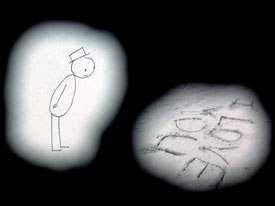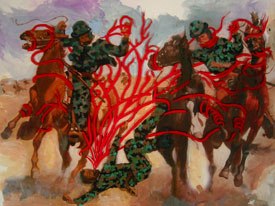Mary Ann Skweres finds creative risktaking, diversity, aesthetic innovation and independent artistic expression at Sundance.

As the preeminent gathering of American indie filmmakers, the Sundance Film Festival strives to program films that embody creative risktaking, diversity, aesthetic innovation and independent artistic expression. These criterions have never been so evident as in the rich sampling of alternate universes created in the eight animated short films showcased at this years Animation Spotlight. To give full rein to their imaginations, the filmmakers have used every available tool, from hi-tech to hand drawn, choosing to experiment with ever expanding digital technologies or grounding their expression in traditional techniques, working in three dimensional photorealistic style or crafting a more impressionistic abstract form to tell their stories. The stories are as varied as the techniques used to bring them to the screen -- from fallen cartoon heroes to the tale of a Manhattan rat; from a primer on the uses of duct tape in biological warfare to a mothers hunt for her lost son in hell. If there ever was a question about the future of animated filmmaking, this years crop of Sundance selections might have an answer.
The Sundance Film Festival 2007 Jury Prize in Short Filmmaking was awarded to Everything Will Be OK (U.S., 2006, 17 min., color & b/w, 35 mm) directed by Don Hertzfeldt. The film also received the Best Animated Short Award at the 2007 Santa Barbara Film Festival. Expanding on the theme explored in his 2005 animated film, The Meaning of Life, Hertzfeldts newest surreal adventure illustrates a series of dark and troubling events that force the protagonist Bill to reckon with the meaning of his life -- or lack thereof. Characterized by Hertzfeldts trademark animated stick figures, the films impressionistic style is flavored with humor as it builds steadily along an absurdist path to its over-the-top climax.

Hertzfeldt single-handedly, wrote, directed and produced Everything Will Be OK. Beginning with the concept, the story was shaped through creative experiments and improvisation, as the project progressed. Hertzfeldt approaches animation traditionally with pen, paper and film, but instead of using traditional key frames, he animates straight ahead. He drew, animated and photographed the thousands of drawings himself, foregoing the use of computers in his animation or photography process. By drawing every single element over and over again, Hertzfeldt creates the jittery, kinetic appearance for his films. He also designed the sound and composed original music for the short.
A UC Santa Barbara graduate, Hertzfeldts animated films have been featured in more than 1,000 film festivals and theatrical venues worldwide. Filmmaker Magazine named him one of the "top 25 directors to watch. In 2003, he co-founded The Animation Show, an animation festival that has successfully booked animated shorts into more North American movie theaters than any other in history.
Animated in an ultra-realistic style One Rat Short (USA, 2006, 10 min., color, 35 mm), written and directed by Alex Weil, founder of the New York design and production studio Charlex, won Best of Show at the prestigious SIGGRAPH 2006 Computer Animation Festival with its dark filmic approach to animation. This melancholy misadventure of love and loss on a gloomy Manhattan night follows a lowly subway rat led by the mesmerizing ballet of a discarded food wrapper to find his angelic, lab rat soul mate only to be separated by the realities of their disparate worlds.
Weil worked with a small team of CGI artists to design the photo-realistic characters and backgrounds. The film contrasts the gritty urban darkness of the heros world with the bright sterility and mechanical efficiency of the laboratory where he meets his beloved. To cement the sense of reality, the film was shot with a live-action inspired, hand-held style. The filmmakers kept the bittersweet story simple, giving it heart through the realistic characterizations of the love struck rats, underscored by a touching musical soundtrack.
For some 25 years, Weil has been a storyteller and technical innovator, pioneering multi-layered video-effects for The Cars You Might Think video, which garnered him the first ever MTV award for Best Music Video. He has received numerous advertising industry awards, an Emmy for his Saturday Night Live titles and a Grammy nomination for his long-form video for the band Yes. His work is included in the permanent collection at MoMA. One Rat Short has already traveled the globe appearing at the Cannes Shorts Corner, the Melbourne International Film Festival, Africas Golden Lion Film Festival, CineVegas and the Los Angeles Film Festival. With one of the largest computer animation facilities on the east coast, Weil plans to segue his success with One Rat Short into a feature-length animation project.

Director Stacy Steers Phantom Canyon (U.S., 2006, 10 min., b/w, 35 mm) is a beautifully surreal journey into the nature of memory inspired by a pivotal relationship in the filmmakers life. In this fantastical recollection, a curious woman encounters enormous insects and an alluring man with bat wings.
Featuring figures from Eadweard Muybridges Human and Animal Locomotion, first published in 1887 and Xeroxed elements of 18th and 19th century engravings, Phantom Canyon is composed of more than 4,000 6x8-inch meticulously handmade collages. To create and animate the characters, the Muybridge figures were used in pieces -- bodies of some with the heads of others, the arms of one on the torso of another -- then collaged to produce the movements necessary for the films narrative flow. Shot with an old Oxberry animation stand onto 35mm film stock, texture layers were added to the collages using transparencies.
Stacey Steers is an award-winning independent animator who teaches in the Film Studies Program at the University of Colorado in Boulder where she lives. Composed of thousands of individual, handmade works on paper, her labor-intensive films take years to produce. She has been awarded residencies at The MacDowell Colony, Harvard University and the Sacatar Foundation.

Joanna Quinns Dreams and Desires -- Family Ties (U.K., 2006, 10 min., color, 35 mm) presents life through the eyes Beryl, a middle-aged woman obsessed with the filmmaking process after acquiring a new video camera. In this cleverly written and directed story, Quinn uses the viewfinder as a device to frame the action from Beryls point of view accompanied by a comedic off camera commentary acted by Menna Trussler. The frenetic hand-held style adds a live-action feel and bolsters the characterization of Beryl as an amateur videographer, who attempts to create a video diary of her friends wedding ends with disastrous hilarity.
Dreams and Desires -- Family Ties was nominated for the 2007 BAFTA Film Award for Best Short Animation. Quinn fell in love with animation while studying graphic design at Middlesex University. Since then she has made six short films, received two Oscar nominations, three Emmy and four BAFTA Awards. She is a committed teacher, teaching in American and Europe.

In Duct Tape and Cover (U.S., 2005, 4 min., color, Sony HD Cam) director, YongJin Park gives his satirical response to the Department of Homeland Security's recent advice for Americans to ready themselves for possible chemical and biological warfare by stocking up on duct tape, while the same time drawing a parallel with equally absurd Cold War era drills instructing children to cover their heads in the event of a nuclear attack.
With roots in South Korea, Park was exposed to American culture as a graduate student at the Art Institute of Chicago where he is an instructor teaching motion graphics. He enjoys experimenting with new methods of creating motion. As a motion graphics designer at the Digital Kitchen in Chicago, he pursues a career in broadcast design, animation and live-action.

Using iconic images to comment on the cowboy mentality pervasive in America, Destiny Manifesto (U.S., 2006, 9 min., color, Sony HD Cam) by director Martha Colburn explores the visual and psychological parallels between the American West and the Middle East. The impressionistic observations on film were created using paint-on-glass -- including bloody red splashes -- and collage animation comprised of paintings of the frontier and contemporary images of the Iraq war. Colburns film, Spiders in Love: An Arachnogasmic Musical won the Best Animation at the Chicago Underground Film Festival.
From director Aaron Augenblick comes the hilarious Golden Age (U.S., 2006, 22 min., color, Sony HD Cam), the shocking true stories of the world's strangest fallen cartoon heroes presented in classic animation style. Augenblick has worked as animation director on episodes of the TV series, Wonder Showzen.
By means of primitive figures, stop-motion animation, dramatic lighting and a rich color palette, Paulina Hollers (USA, 2006, 15 min., color, Sony HD Cam) by director Brent Green tells the story of a religious zealot mother commits suicide to try to find her dead son in hell and escape with him.
Mary Ann Skweres is a filmmaker and freelance writer. She has worked extensively in feature film and documentary post-production with credits as a picture editor and visual effects assistant. She is a member of the Motion Picture Editors Guild.








